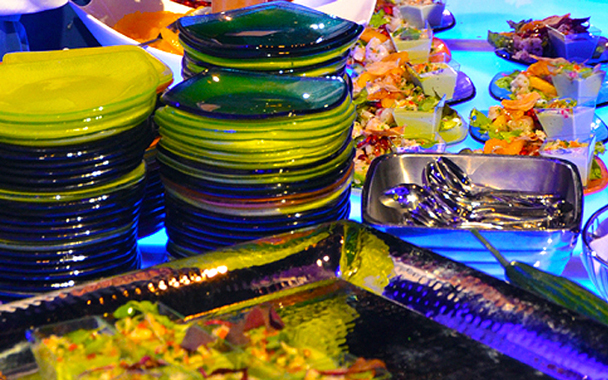You can tell a lot about a culture based on the way it eats. Dinner forks originated in the courts of the Byzantine empire, among nobles so decadent they wouldn’t deign to dine with their hands. The French Revolution gave birth to the first restaurants, democratizing pleasures previously available only in the homes of the rich. Brunch we owe to an indolent British aristocracy for whom rising for breakfast was a bridge too far. And where else but America, the nation of perpetual grazers and competitive eaters, could the mass-scale, stroll-and-snack tasting event take purchase?
If you’ve so far managed to avoid this genre of perambulatory feeding, here’s the basic scheme: Round up anywhere from a dozen to hundreds of restaurants, give them each a table and some rudimentary cooking equipment, and unleash a large, hungry mob upon them for a roving dinner. Over the course of the past two decades, this format has spread like wildfire, with countless American food festivals and tastings now taking place each year. The massive, no-frills Taste of Chicago event may be the category killer in terms of annual attendance, yet the concept exists on all scales and has become a favorite fund-raiser of charities, for obvious reasons: Organizations can sell many more tickets for a roaming cocktail party than a for sit-down gala, and aren’t on the hook to provide a full dinner. But don’t think the absence of a proper meal entitles you to a bargain. Tickets for these tastings tend to range from $75 to $250 (depending on the number and caliber of restaurants participating), which seems to be a staggering sum of money for food you have to wait in line to consume.
I first got up close and personal with walk-arounds, as they’re known in restaurant industry shorthand, a few years ago while working as Tom Colicchio’s assistant. Part of my job was to oversee his New York restaurants’ participation in these events. Colicchio is a generous man, so between Craft, Craftbar, Colicchio & Sons, and Riverpark, we might do 25 charity events of this kind in a given year. In the course of two years spent slinging tasting portions for crowds, I never did understand what kept people coming back time and time again.
For a restaurant, each event poses its own unique and exasperating obstacles to producing good food. One site has no running water; another sets you up with a nonfunctioning electrical outlet; a third loses the bowls you requested, so, oops, guess you’ll have to serve that lobster velouté on plates? The preparations tend to be hectic at best, absurd at worst, involving more sweat, fire extinguishers, duct tape, and whiskey than I care to remember. As a ticket buyer, you’re kidding yourself if you think that the food you get under these circumstances is of the same quality that emerges from the controlled environment of a restaurant kitchen. You’re getting whatever can be turned out at a breakneck pace on a slanted card table with a hot plate and a few plastic forks.
Despite the logistical challenges, Colicchio’s chefs would always dedicate extensive effort and expense to produce something that did each restaurant proud, like handcut hamachi crudo or generous portions of grilled lamb ribs. Some of our fellow participants went to similar lengths, but there were always those who phoned it in with butternut squash soup or some bullshit bruschetta. We’d snicker, yet it was hard to blame some for taking shortcuts while watching the umpteenth guest blow past, shove a perfectly executed sliver of foie gras au torchon into his maw, and move on without so much as an acknowledgment.
These days, I experience walk-around tastings purely from a consumer standpoint, and my impatience with the format has only intensified. It strikes me that unless you have some kind of hunter-gatherer fetish, there’s nothing pleasant about the dining experience at these tastings and festivals—scanning the scene for pockets of open space, darting from table to table or stall to stall, muscling your way through the bodies to grab a plate of whatever’s on offer. The format turns the act of eating—which, at its best, should be pleasurable, relaxing, even thought-provoking—into a competitive sport.
Once you’ve managed to score a piece of food, eating it poses further problems, as you struggle to balance a glass of wine in one hand and your hard-won disposable plate full of lasagna in the other. If you’ve brought a date, you can take turns feeding each other, sort of like monkeys. Otherwise, and especially if the item you’re wrestling with takes two hands and cutlery, you’ll need to roam around looking for a perch so you can furtively stuff your food down your gullet before it gets cold.



 Pinterest
Pinterest


